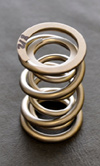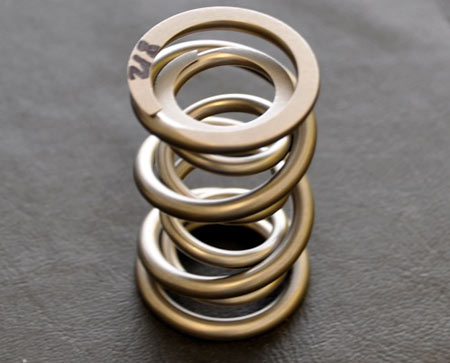Bad valve spring wire can ruin a racer's title hopes
 In the Pro Stock Motorcycle category of NHRA Full Throttle Drag Racing Series, there are three engines currently in the game. Only the two-rider Vance & Hines team uses the Harley-Davidson Screamin' Eagle, while the balance of the field is split between the Buell engines, supplied by S&S Racing, and Suzuki engines, furnished by Vance & Hines' workshops.
In the Pro Stock Motorcycle category of NHRA Full Throttle Drag Racing Series, there are three engines currently in the game. Only the two-rider Vance & Hines team uses the Harley-Davidson Screamin' Eagle, while the balance of the field is split between the Buell engines, supplied by S&S Racing, and Suzuki engines, furnished by Vance & Hines' workshops.
While Harley-Davidson puts a good deal of support behind its factory team, and S&S has managed to get NHRA to open up the specs a bit on the Buell engine, the Suzuki teams are really behind in terms of technology. Only one team builds its own engines: White Alligator Racing, with second-year rider Jerry Savoie.
In 2011, Savoie began the season with a standard Suzuki motorcycle, but at the prestigious Mac Tools US Nationals, he changed to the Hayabusa Suzuki that was developed by Don Schumacher Racing, before that team decided to pull out of the class. Savoie, an alligator farmer by trade, bought the entire stock of motorcycles and spares from Schumacher and had Mark Peiser build his engines.
The partnership worked well, and Peiser had the new Hayabusa motorcycle ready for action at the US Nationals in the first week of September. There were only two drawbacks Peiser encountered as he began this new adventure with the engine in the new Hayabusa chassis - a dearth of crankshafts and valve spring failures.
"When we bought all the equipment from Schumacher, we had probably 15-20 valve springs that came with the deal. We were running out of springs and I discovered they were a special order spring for this application," Peiser explained.
His supplier had problems duplicating the original springs that came with the Schumacher-built engine, and Peiser stressed it was not the vendor's fault. "It was all about the wire to wind the spring; they got an inferior wire and it made the rest of our season very, very difficult," as Savoie had qualified for the play-off Countdown to the Championship that decides the class champion by the end of the year. He was also in the running for the Auto Club Road to the Future rookie of the year award, so any misstep was costly.
"We just struggled throughout the Countdown with worn-out springs," Peiser said. "The ones I got for the Nationals just wouldn't live: they would lose about 30 lb off the seat pressure on the dynamometer - not even on the track. We tried a different one with a different heat treatment, but that didn't work because they were too brittle and they broke. I broke two in one run at Dallas last fall," he said. It was a dilemma that pushed Savoie back to eighth in points at the end of the year.
The supplier has new wire "and it looks like those springs are going to be good," Peiser said.

He uses a double-valve spring with four coils each on the outer and the inner spring. The material is tool steel, and he said the harmonics are measured at 640 Hz, "Which I believe to be good," he said. Installed pressure is 220 lb and the new springs "only dropped about 5 lb on the dyno, which is good. On the track they'll probably lose 7-8 lb and then settle and stay that way so I can get 20 runs out of them, and that will be huge," for a man who was changing valve springs in 2011 like they were socks.
Peiser checks every single valve spring when he receives it. "I have a certain number that I check them at," he said. "I'll go through the whole batch and check every one, and actually write on the ends what that number is. That way I can run a matched set. If I've got 100 springs, I'll put springs in the engine that have the same installed pressure," Peiser said.
"I'm a valve spring fanatic," he admitted. "I'll change springs when they probably don't need to be changed just so I know we've got good, fresh springs in an engine. I know how important that is and I'll change them every ten to 15 runs instead of 20, just to be on the safe side." The manufacturer shot-peens the springs, he said, and Peiser assured me he doesn't make any changes to his springs other than measuring them for seat pressure.
New valve springs didn't do all the tricks to keep the Suzuki running though. Over the winter, Savoie decided to park the Hayabusa and move to a Buell. "With a Suzuki, you're kind of out there by yourself [without any factory support], but we're not going to abandon the Suzuki; we may run them both."
Fig. 1 - Mark Peiser notes the seat pressure on every valve spring he receives in order to get matched sets (Photo: Anne Proffit)
Written by Anne Proffit